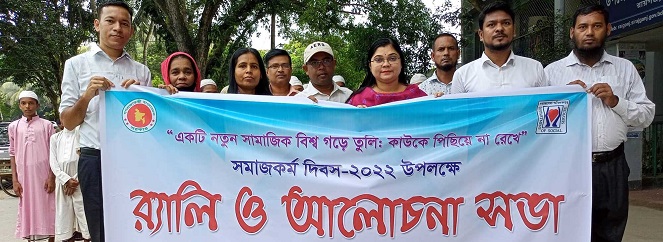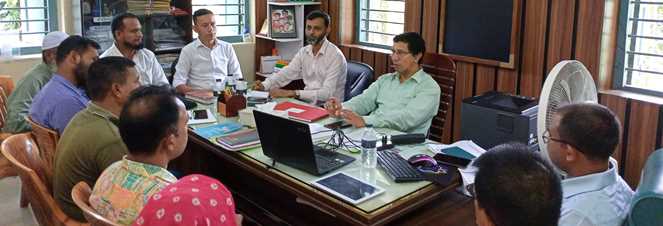-
- About Us
-
Our services
Inspection
-
Higher Offices
Division / District
Ministry / Department
- E-Service
- Gallery
- Contact
- Opinion & Suggestion
-
- About Us
-
Our services
Inspection
-
Higher Offices
Division / District
Ministry / Department
- E-Service
-
Gallery
Photo Gallery
Video Gallery
-
Contact
Office Contact
Communication Map
-
Opinion & Suggestion
opinion and feedback
Financial assistance program for patients suffering from cancer, kidney, liver cirrhosis, paralyzed by stroke, congenital heart disease and thalassemia
Every year about 3 lakh people die of all these diseases in the country and 3 lakh people are suffering from cancer, kidney, liver cirrhosis, paralyzed by stroke, congenital heart disease and thalassemia. As the patients suffering from these diseases die due to lack of money, their families are destitute due to the cost of treatment. This program is being implemented under the social security program with the aim of providing a one-time financial assistance of 50,000 (fifty thousand) taka to all the poor patients suffering from cancer, kidney and liver cirrhosis through the Department of Social Services of the Ministry of Social Welfare.
definition
1. cancer
The body of all animals in the world is made up of countless tiny cells. These cells die over a period of time. These old cells are replaced by new cells. Cells in general; Gives rise to new cells by dividing in a controlled and orderly manner. Simply put, when these cells grow uncontrollably for some reason, lumps or lumps appear under the skin. This is called a tumor. These tumors can be benign or malignant. Malignant tumors are called cancer. Briefly, cells that divide uncontrollably and grow are called neoplasia (tumors) and the malignant form of these neoplasias is called cancer.
2. Kidney disease
When the kidney gradually loses its function, various problems occur in the body. If the kidney disease is more advanced, the toxic substances in the blood increase and the feeling of sickness starts. Along with this, high blood pressure, anemia (lack of red blood cells), bone weakness, malnutrition, neurological damage can occur. Chronic kidney disease can increase heart and blood vessel disease. The progression of these diseases and illnesses occurs slowly and over long periods of time. Diabetes, high blood pressure and other metabolic disorders can lead to chronic kidney disease. Early diagnosis and treatment can cure or control the disease or slow the rate at which it gets worse. If the disease progresses rapidly and at some point the kidneys fail, artificial blood purification i.e. dialysis is required and life can be saved by kidney transplantation.
3. Liver cirrhosis
Cirrhosis is a chronic disease of the liver, in which the normal architecture of the liver is destroyed and the liver loses its normal function. In many cases, cirrhosis of the liver can also lead to liver cancer.
4. Paralyzed by stroke
Stroke may be defined as sudden Neurological deficit which persists for 24hrs or patient may die within 24hrs which is non traumatic vascular origin. .
5. Congenital heart disease
A baby's heart can have various birth defects (developmental anomalies) at the time of birth. Among these, holes in the heart (atrial septal defect, ventricular, septal defect), tretalgia of Fallot, patent ductus arteriosus etc. are notable. Due to all these congenital heart defects, on the one hand, the physical and mental growth of the child is hindered, and these defects gradually become incurable. The result is certain death. If appropriate treatment such as cardiac surgery or device closure can be performed before it becomes incurable, patients can lead healthy and normal lives.
6. Thalassemia
Thalassemia is a hereditary blood disorder. In this disease there is a defect in the production of hemoglobin particles that carry oxygen in the blood. People with thalassemia usually suffer from lack of oxygen in the blood or anemia. Anemia can cause anything from lethargy to paralysis. Thalassemia can be of two main types: alpha thalassemia and beta thalassemia. Alpha thalassemia is generally less severe than beta thalassemia. Symptoms in people with alpha thalassemia are mild or moderate in nature. On the other hand, in case of beta thalassemia, the severity or prevalence of the disease is much higher; If not treated properly in one-two-year-old babies, it can cause death of the baby. Children suffering from this disease show paleness and weakness and stunted growth. The spleen becomes enlarged and the stomach swells. Bones widen and become deformed and physical growth is disrupted. Regular blood transfusions are the main treatment for thalassemia major. Bone marrow transplantation is an effective treatment for thalassemia. Thalassemia is curable. But since it is a congenital problem, if the genetic problem is not changed, i.e. the organ producing the problematic hemoglobin, i.e. the bone marrow (bone marrow), if it can be changed by bone marrow transplantation, it can be completely cured.
Aims and Objectives:
a) Providing medical assistance to poor patients suffering from cancer, kidney, liver cirrhosis, paralyzed by stroke, congenital heart disease and thalassemia;
b) Helping the family of the affected patient to bear the expenses;
c) Helping to return to a healthy and normal life.
Program implementation strategy
Identifying poor patients suffering from cancer, kidney, liver cirrhosis, paralyzed by stroke, congenital heart disease and thalassemia, social services department manpower, local administration, h
Planning and Implementation: Cabinet Division, A2I, BCC, DoICT and BASIS








